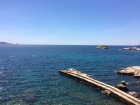Brief Itinerary of a pharmacognost
Overview
I am licensed pharmacist with a doctoral degree in Pharmacognosy obtained in 2010 at the University of Strasbourg.
From 2011-2019, I worked at the University of Illinois at Chicago first as a post-doctoral associate in the botanical center for dietary supplement research, then as a research assistant professor in the Center for Natural Product Technologies (CENAPT), and in the Institute for Tuberculosis Research (ITR).
In 2019, I have been hired as a CNRS scientist, natural product chemist, to develop projects at the interface between chemical ecology and drug discovery with the valorisation of biological properties of molecules produced by diverse organisms (e.g. plants, microorganisms, other marine organisms) with an emphasis on marine sponges.
Current Project
Together with my DFME colleagues at the marine station, I am working on innovative methods to capture, concentrate and characterize metabolites released by marine organisms, notably sponges, in the seawater.
Check out the SESAM project here
Scientific Itinerary
Key words
Pharmacognosy, multi-modal characterisation of natural products, analytical chemistry, structure determination, Metabolomics, (q)NMR analyses, Countercurrent Chromatography (CPC)
2007-2010 PhD student
Working on Vanda (Orchidacea)
Advisor Annelise Lobstein (UMR CNRS 7200) at Strasbourg University. CIFRE fellowship with LVMH-research
My project was dedicated to the phytochemical and biological investigations of Vanda coerulea Girff ex. Lindl and Vanda teres (Roxb) lindl (Orchidaceae). The project involved the isolation and structural characterization of major compounds ( e.g. stilbenoids) present in the stem extracts, as well as the evaluation of their anti-inflammatory and anti-ageing properties in cell-based in vitro assays.
2011-2015 Post-doctoral Associate
Working on Licorice (Glycyrrhiza)
Center for Botanical Dietary Supplements Research:
My research involved a thorough characterization of licorice botanicals (Glycyrrhiza species) through the development of innovative phytochemical methods with the implementations of quantitative NMR, countercurrent chromatography and DNA barcoding. I worked together with biologists to prepare chemically defined licorice extracts for estrogenic bioassays, and to identify bioactive metabolites (e.g. characteristic flavanones and chalcones most often prenylated).
2015-2019 Research Assistant Prof.
Working on diverse Plants and on Microorganisms
CENAPT (Director Guido F. Pauli):
My research involved the preparation of chemical knock-out extracts by selectively removing target compounds to study the impact of complex matrices on the activities measured with single compound. For that purpose, we used countercurrent chromatography.
In line with this research, we recently proposed a method to remove chlorophylls from botanical extracts. Check it out here:
Other activities performed in collaboration:
– Multi-modal characterisation of plant materials used for bioassays
– NMR and MS analysis to confirm the identity, purity but also the stability of compounds tested in bioassays
Since 2016, I actively participate in the diffusion of raw NMR data to promote transparency and facilitate future compound identification. Check the guidelines in collaboration with Harvard Dataverse here:
Institute for Tuberculosis Research (Director Scott G. Franzblau):
I worked on a process dedicated to the exploration of minor and potentially novel specialized metabolites produced by genetically characterized Streptomyces. I consolidated my knowledge on liquid and solid-based fermentation of Actinomycetes, and on the assays used to determine the anti-mycobacterial properties of purified compounds and extracts.
This last research project reinforced my interest in studying anti-microbial metabolites produced within a symbiotic system. Sponges are a perfect example of such symbiosis.
I am deeply thankful to the great advisors, mentors and colleagues I met, with whom I worked and continue to collaborate.





